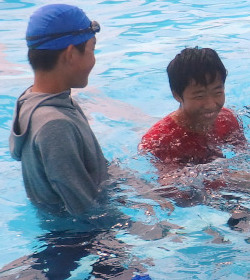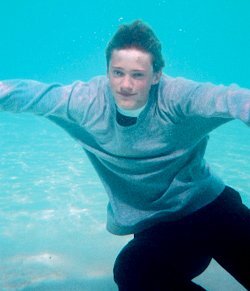Sea Survival Centre
Story by Robyn, a freelance contributor
The local sea training centre offers a variety of exciting safety courses, mostly practical pool sessions, even for non-swimmers. I work in their pool as a qualified lifeguard and trainer. This involves going into the water several times a day to make sure everyone is safe.
The knowledge and experience that each survival course provides helps visitors to deal with emergencies proficiently and pragmatically, greatly increasing their chances of getting back to shore alive.
Our centre has several smaller pools for different training classes or lessons.
This lets us run courses concurrently.
On some days I move quickly between pools to help out without a break to dry out in between,
so I wear extra clothes with a spray suit on top to stay warm.
The show must go on, no matter how wet I get.
My Work Day
The centre opens at 06:00 for the staff and at 07:30 for visitors. Courses start at 08:00 and run until 18:00, or into the evening. These are long days, but in a four day week. On my off-days I go in for my own fitness training, or just for fun.
I live right next door, but spend most of my time in the training centre, because I really enjoy water sports. As soon as I wake up I go there, have a shower in my sportswear and then go into the pool.
Before we let the public in, we make sure the pool is safe and clean. This involves hosing down the poolside and often each other, and stow everything in its place. There maybe bits from the previous session on the pool bottom, so I jump in and fetch them. At 07:00 I change into dry clothes and enjoy a healthy breakfast.
I must start each session in dry clothes for the theory briefing, can't go dripping wet into the dryside rooms. In the staff room are lots of clothes for our team to wear and a hot drying room by the heating system to hang them up after each session. We have to be ready to go into the pool anytime fully clothed without hesitation to help and assist. It's a health and safery consideration.
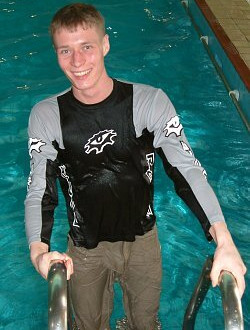
Mostly I wear quick drying sports clothes because I often have to go into the pool at short notice.
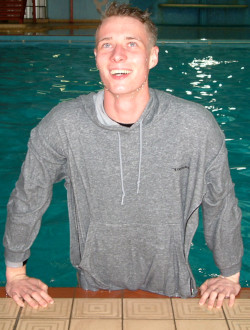 For survival swimming lessons and other water sports I prefer a comfy jogging suit or onesie.
For survival swimming lessons and other water sports I prefer a comfy jogging suit or onesie.
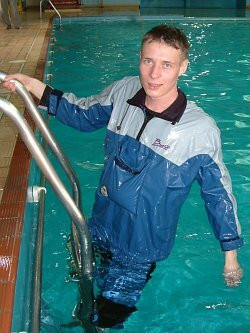
For sea survival courses I have to wear full wet weather gear with warm clothes underneath.
Sea Survival in Life Rafts
The Sea Survival Training Courses are designed to teach the basics of sea survival in a safe environment to ensure that you have the skills to deal with a problem should it arise. The course is suitable for beginners and as such there are no pre-requisites, although a familiarity with boats is advantageous. There is no minimum age but secondary school age is a sensible minimum.
The course is delivered by an instructor, who is joined by a second staff member for the pool session, either me or a colleague. Everbody, including staff, dresses in whatever they would wear in adverse conditions at sea, including warm clothes, wet weather gear, boots and lifejacket.
The best part of this course is the water practice involving a life raft in the heated indoor pool. It is physically demanding and requires a good level of fitness. My task is to into the water with the visitors and keep them safe.
The instructor teaches how to correctly wear, inflate and swim in a life jacket, how to dress for rough weather and swim in clothes, how to launch a life raft and best boarding techniques as well as provide insight into sea survival techniques by utilising the equipment in the life raft.
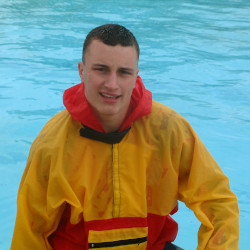
Instructor Alexei in the required wet weather gear

Non Swimmers
Non swimmers also attend the training courses, a most important group to teach. All non swimmers have a safety swimmer with them at all times when they are in the water. That is usually my job for which I have to wear sports clothes or a jogging suit.
For all courses and swimming lessons they wear special bouyancy aids or life vests over their clothing. This lets them experience all the fun and exitement of our courses and what it feels like to be in the water fully clothed for a longer time. They wear the same kit for swimming lessons. This is a great teaching tool. Clothes force them to do a swim stroke right or they don't move forward.
It is important to remember that nothing will be forced on people,
so if they want to get out of the water at any stage they may do so.
This is supposed to be fun and educational, so we make it as relaxed and pleasant as possible.
Going into the water fully clothed is all part of this.
Schools
Swimming is the one skill you can learn in school that may save your life one day. The morning sessions usually get booked by the local schools for swimming lessons. They have a strong emphasis on survival which is why they come to us.
Their swimming lessons are designed to build strength and water confidence. This may include an obstacle course, or practice how to deal with breaking into a frozen lake. We have the requisite floats and equipment for such training.

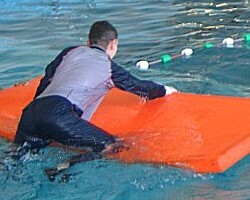
Sea Cadets
The Sea Cadets come once a week for various pool exercises that they can't do in regular pools. Apart from always swimming fully clothed, they practice boat handling and other aquatic skills or games, like setting up a tent underwater. When lifeguarding them in the pool, I'm expected to wear a full set of clothes in the water, including socks and canvas shoes. to look the part like they do.
